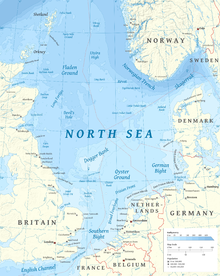Dogger Bank
Dogger Bank (Dutch: Doggersbank, German: Doggerbank, Danish: Doggerbanke) is a large sandbank in a shallow area of the North Sea about 100 kilometres (62 mi) off the east coast of England.
During the last ice age the bank was part of a large landmass connecting
At the beginning of the 21st century the area was identified as a potential site for a UK
Name
The name Dogger Bank was first recorded in the mid-17th century. It is probably derived from the word "dogger" used for a two-masted boat of the type that trawled for fish in the area in medieval times.[2] The area has similar names in Dutch, German, and Danish.
It gives its name to the Dogger sea area used in the BBC Radio 4 Shipping Forecast.
Geography
The bank extends over about 17,600 square kilometres (6,800 sq mi), and is about 260 by 100 kilometres (160 by 60 mi) in extent.[3] The water depth ranges from 15 to 36 metres (50 to 120 ft), about 20 metres (65 ft) shallower than the surrounding sea.[citation needed]
Geology
Geologically, the feature is most likely a
The 1931 Dogger Bank earthquake took place below the bank, measuring 6.1 on the Richter scale and was the largest earthquake ever recorded in the United Kingdom. Its hypocentre was 23 kilometres (14 mi) beneath the bank, and the quake was felt in countries all around the North Sea, causing damage across eastern England.
South of Dogger Bank is the Cleaver Bank.
- Battle of Dogger Bank (1696), during the Nine Years' War a French fleet under the command of Jean Bart was victorious over the ships of a Dutch force of five ships and the convoy it was escorting.
- Battle of Dogger Bank (1781), during the Fourth Anglo-Dutch War, a Royal Navy squadron fought a Dutch squadron on 5 August 1781.
- Dogger Bank incident, during the Russo-Japanese War, Russian naval ships opened fire on British fishing boats in the area of Dogger Bank on 21 October 1904, mistaking them for Japanese torpedo boats.
- First World War, saw battles between the Royal Navy and the German High Seas Fleet.
Several
Ecology
The bank is an important fishing area, with cod and herring being caught in large numbers. Dogger Bank has been identified as an oceanic environment that exhibits high primary productivity throughout the year in the form of
Trawling and protected areas
In September 2020,
Wind farm and wind power hub
The Dogger Bank was selected for offshore wind farms because it is far away from shore, avoiding complaints about the visual impact of wind turbines, yet the water is shallow enough for traditional fixed foundation wind turbine designs.[9] Fixed-foundation wind turbines are economically limited to maximum water depths of 40 to 50 m (130 to 160 ft; 22 to 27 fathoms);[10] at greater water depths new floating wind turbine designs are required, which currently cost significantly more to build.[11]
In January 2010, a licence to develop a
Construction was scheduled to start around 2014 at the earliest, but has been repeatedly postponed.[13]
Dutch, German, and Danish electrical grid operators are cooperating in a project to build a
See also
- Dogger – British maritime weather report and forecast, the name of one of the sea regions of the British Shipping Forecast
- Dogger Bank itch – medical condition, a dermatological condition common in North Sea fishermen
- North Sea Wind Power Hub – wind farm in the UK
- Fishing in the North Sea
- Other places under the North Sea:
- Broad Fourteens – Area of the southern North Sea
- Devil's Hole (North Sea) – Group of deep trenches in the North Sea east of Dundee, Scotland
- Fisher Bank – Bank in the North Sea
- Fladen Ground
- Long Forties – Zone of North Sea
- Silver Pit – Fishing ground and submerged valley in the North Sea
- Outer Silver Pit – deep in the North Sea
- Inner and Outer Dowsing sand banks – bank in the North Sea
References
- Independent.co.uk. 10 March 2017.
- ^ . Encyclopædia Britannica. Vol. 08 (11th ed.). 1911. pp. 380 to 381.
- ^ S2CID 128904893.
- ^ Spinney, Laura (25 Apr 2013). "Searching for Doggerland – National Geographic Magazine". Ngm.nationalgeographic.com. Archived from the original on November 26, 2012.
- ^ Duff, Joel (24 Feb 2014). "Fishing for Fossils in the North Sea: The Lost World of Doggerland – Naturalis Historia". Thenaturalhistorian.com.
- ^ "The Dogger Bank – A Potential MPA" (PDF). WWF. Archived from the original (PDF) on 2007-01-28. Retrieved 15 Oct 2008.
- ^ "Dogger Bank". JNCC.
- ISSN 0963-1496.
- ^ Harvey, Fiona (17 Feb 2015). "World's biggest offshore windfarm approved for Yorkshire coast". The Guardian.
- ^ "Deep Water - The next step for offshore wind energy". WindEurope.org. European Wind Energy Association. 31 July 2013. Retrieved 26 July 2017.
- ^ Martin, Richard. "Floating Wind Farms: Great Concept, Implausible Economics". MIT Technology Review. Retrieved 26 July 2017.
- ^ Laister, David (19 Feb 2014). "Dogger Bank wind farm zone to be scaled back by 20 per cent". Grimsby Telegraph. Archived from the original on 2014-05-02.
- ^ "New UK offshore wind farm licences are announced". news.bbc.co.uk. January 8, 2010.
- ^ "Artificial island is planned on Dogger Bank for cheaper wind power". Sky News. 13 March 2017.
- ^ "First meeting of North Seas Energy Forum". European Commission. 22 March 2017. Retrieved 23 March 2017.
External links
 Media related to Dogger Bank at Wikimedia Commons
Media related to Dogger Bank at Wikimedia Commons


